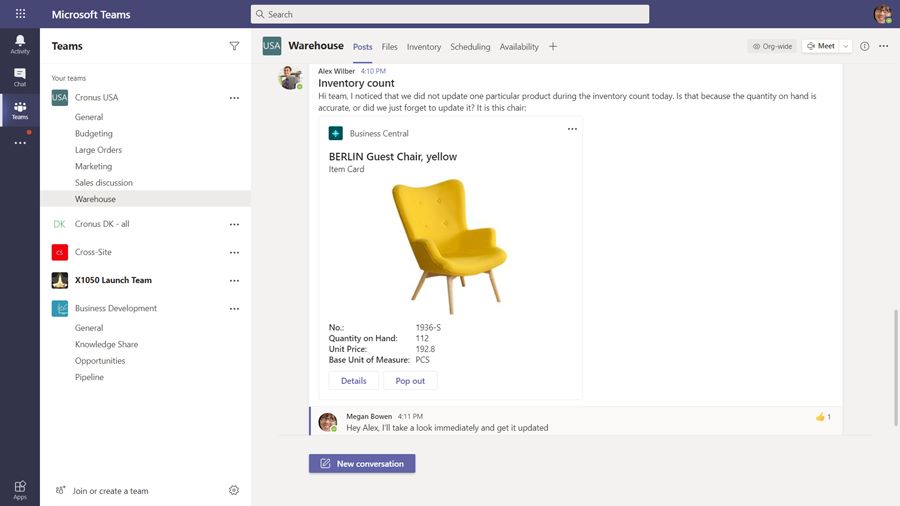This article is contributed. See the original author and article here.
The pace of business operations continues to accelerate daily, presenting an ongoing challenge for employees who increasingly struggle to keep up. They often find themselves overwhelmed by the very tools designed to enhance their work, leading to frequent switching between various documents, apps, and websites as they hunt for data.

Harvard Business Review addresses this issue in its article How Much Time and Energy Do We Waste Toggling Between Applications?, where it describes the prevalent “swivel chair” approach to work, which has become the norm for most employees. This is primarily because many software applications weren’t originally designed to connect with each other. Consequently, employees often serve as the connective tissue bridging the gap between these disparate applications. They engage in manual processes of fetching, transforming, and submitting data from one system to another, constantly shifting between apps. This practice is both time-consuming and mentally draining.
The true cost of this constant app-switching becomes apparent when we consider that the average user toggles between different apps nearly 1,200 times each day, spending approximately four hours per week reorienting themselves after switching to a new application. Annually, this adds up to a staggering five working weeks, accounting for a significant 9% of their total work time.1
What’s the solution to this productivity-sapping dilemma? The answer lies in connecting business systems and productivity tools, providing employees with easy access to the information they need without switching between applications. Seamless sharing of data across tools and applications not only simplifies access for employees but also lays the foundation for AI and Microsoft Copilot to offer proactive insights and assistance within their everyday tools.
With Microsoft Dynamics 365 Business Central and Microsoft 365, businesses can establish a unified experience where data seamlessly connects with productivity apps including Excel, Outlook, and Microsoft Teams. This connectivity ensures that employees can access timely information, gain valuable insights, and collaborate directly within the tools they use daily—all without the need to switch between applications.
By harnessing connected solutions powered by real-time data, businesses can begin to unlock the full potential of AI-enabled productivity with Microsoft Copilot. With Copilot, businesses can automate tasks and guide users through assisted workflows—saving them time, improving collaboration, enhancing decision-making, and allowing employees to focus on what truly matters—driving business success.
More collaboration with Business Central and Teams
Modern workplaces are challenged by fragmented data and communication tools—employees often find themselves juggling various apps and struggling to disseminate timely information, making collaboration difficult. With Teams connected to Business Central, your organization can efficiently share and interact with real-time data, transforming Teams into a centralized hub for your daily operations.

With Business Central and Teams, employees can:
- Make data accessible and collaborative. With Teams connected to Business Central, timely data can be shared in group chats or channels, transforming Teams into the hub for all and daily operations that unite employees, processes, and the data they need to work together.
- Take action from the app they prefer. From Business Central, quickly share data to jumpstart conversations in Teams. From Teams, stay in the flow of work by viewing and editing business data without having to switch apps.
- Streamline collaboration across departments. Empower each department to self-serve by unlocking the data they need to work better together—even without a Business Central license. Get read-only access to Business Central data in Teams at no additional cost with your Microsoft 365 license.
More productivity with Business Central and Excel
Employees often find themselves working in specific applications that align with their roles and responsibilities. For finance and operations teams, Excel is a fundamental tool that plays a pivotal role in their daily tasks. Enabling these teams to maximize their productivity within their preferred application can lead to significant productivity gains.
With Business Central and Excel, employees can:
- Simplify daily tasks. Export any Business Central data to an Excel worksheet to capture data snapshots or share for review. Save time by updating records in bulk in Excel and uploading the revised records to Business Central with just a few clicks.
- Go from raw data to insights faster. Get timely operational insights from Business Central as Excel reports and adapt quickly by customizing report layouts as Excel worksheets. Easily analyze transactions and business data using pivot tables, charts, and calculations to get answers quickly.
- Collaborate in the tools where teams work best. Streamline team-based activities like budgeting and planning with multi-player co-authorship and functionality. Create, edit, and access Excel documents as a team, then publish the final outcomes back to Business Central.
More impact with Business Central and Outlook
At the core of most businesses lies the unwavering commitment to deliver exceptional products and services to its customers. To achieve this goal, businesses must foster strong and meaningful relationships with their clients, vendors, and stakeholders. With Business Central and Outlook working together, employees gain valuable business insights delivered directly to their inbox, so they can save time while staying focused on delivering extraordinary experiences.
With Business Central and Outlook, employees can:
- Enhance customer experience directly from their inbox. Connect real-time data from Business Central to Outlook. Save time with visibility into customer and vendor information like sales, purchase details, and more without leaving their inbox.
- Stay in the flow of work. Use templates to quickly send payment reminders, order confirmations, and other emails directly from Business Central connected to a shared mailbox.
- Go from quote to cash without leaving Outlook. Set up customers or vendors, create quotes, submit invoices, and more from within Outlook so employees can focus on the task at hand.
Embrace the future of work with AI and Dynamics 365 Business Central and Microsoft 365
When Dynamics 365 Business Central and Microsoft 365 work together, small and medium-sized businesses can boost productivity and redefine how work gets done. With data delivered directly to familiar apps like Excel, Outlook, and Teams, employees get the information they need without switching between applications. Using next-generation AI with Microsoft Copilot, employees can further streamline routine tasks like drafting content, summarizing meetings, providing email follow up, and quickly finding answers to questions—all within the tools where they work best.
Learn more about connecting your data with Business Central.
Sources:
1 Harvard Business Review, How Much Time and Energy Do We Waste Toggling Between Applications, 2022
The post Microsoft Dynamics 365 Business Central and Microsoft 365: Connect data to the tools where work is done appeared first on Microsoft Dynamics 365 Blog.
Brought to you by Dr. Ware, Microsoft Office 365 Silver Partner, Charleston SC.


Recent Comments